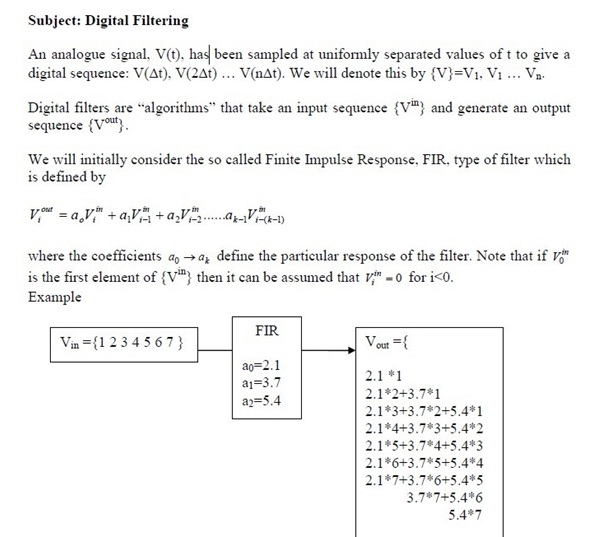Reference no: EM13914316

Define a class, float_seq, to encapsulate a sequence {V} of samples using float precision.
Sequences are to be fully initialized with their data on creation.
Provide (member?) functions that read and write the i'th element in a float_seq andwhich check for valid i, warning the caller (how?) in the event of an invalid value.
Provide a (member?) function to allow read only access to the number of elements in the float_seq.
Provide a (member?) function that zeros all the elements of the sequence.
Define a class FIR to encapsulate the FIR filter using float precision.
Filters are to be fully initialised on creation.
Provide (member?) functions that read and write the ith coefficient of the filter and which check for valid i, warning the caller in the event of an invalid value.
Provide a (member?) function that returns a (reference to, pointer to or instance of -as you feel appropriate?) float_seq containing the filter coefficients.
Both classes float_seq and FIR are to be equipped with destructors, copy constructors and assignment operators.
Overload the stream operators for the float_seq and FIR classes.
Overload the + operator for the class float_seq so that the following,
float_seq a,b,c;
c=a+b;
means concatenation, i.e. that the sequence c consists of the values of sequence a
followed by those of sequence b, e.g. {1,2,3,4} + {5,6,7,8,9}={1,2,3,4,5,6,7,8,9}
Provide a (member?) function for the class FIR whose argument identifies an input
float_seq, applies the filtering operation to that sequence and returns the output
float_seq (reference to, pointer to or instance of - as you feel appropriate?)
Write a main code that reads filter coefficient data from the file filter.txt and creates a filter, reads an input float_seq from the file input.txt, filters the input float_seq using the filterand then writes the output float_seq to the file, output.txt. The input file format is
4 Number of filter coefficients
1 2 1 2 The coefficients
6 Number of values in the data sequence
1.4 5.2 2.5 1.1 1.7 9.3 The data sequence
|
Artificial intelligence
: Translate each of the following sentences into predicate calculus, conceptual dependencies, and conceptual graphs:
|
|
Demand and supply analysis
: What are your predictions? For each part, sketch a graph showing the appropriate demand and supply analysis.
|
|
Create an excel spreadsheet for a production plant
: Create an Excel spreadsheet for a production plant, Use a 40% tax rate, a 10% cost of capital, and a 12% reinvestment rate. Assume the company will use cash flow to finance the project.
|
|
What are the arguments for using a neighborhood analysis
: What are the arguments for using a neighborhood analysis approach for AML-ALL class predication? Indicate if you agree or disagree with their approach.
|
|
Digital filtering
: Write a main code that reads filter coefficient data from the file filter.txt and creates a filter, reads an input float_seq from the file input.txt, filters the input float_seq using the filterand then writes the output float_seq to the file, output..
|
|
New belgium social initiatives indicative
: Are New Belgium’s social initiatives indicative of strategic philanthropy? Why or why not? you will find this question in case study also. u can also read whole case study from there.
|
|
Explain given statements
: Explain what the following statement by handel [1982,p 36] means and provide an argument to either support or oppose the contention
|
|
Prepare a daily level schedule for xyz
: a) Prepare a daily level schedule for XYZ, assuming a container size of 50 for each product. Calculate the number of kanban cards required for each product, assuming a 2 hour lead time and a 15% safety stock. What is the total number of kanban cards ..
|
|
Prepare all necessary consolidation entries
: Prepare all necessary consolidation entries for a January 2, 2013 balance sheet.
|